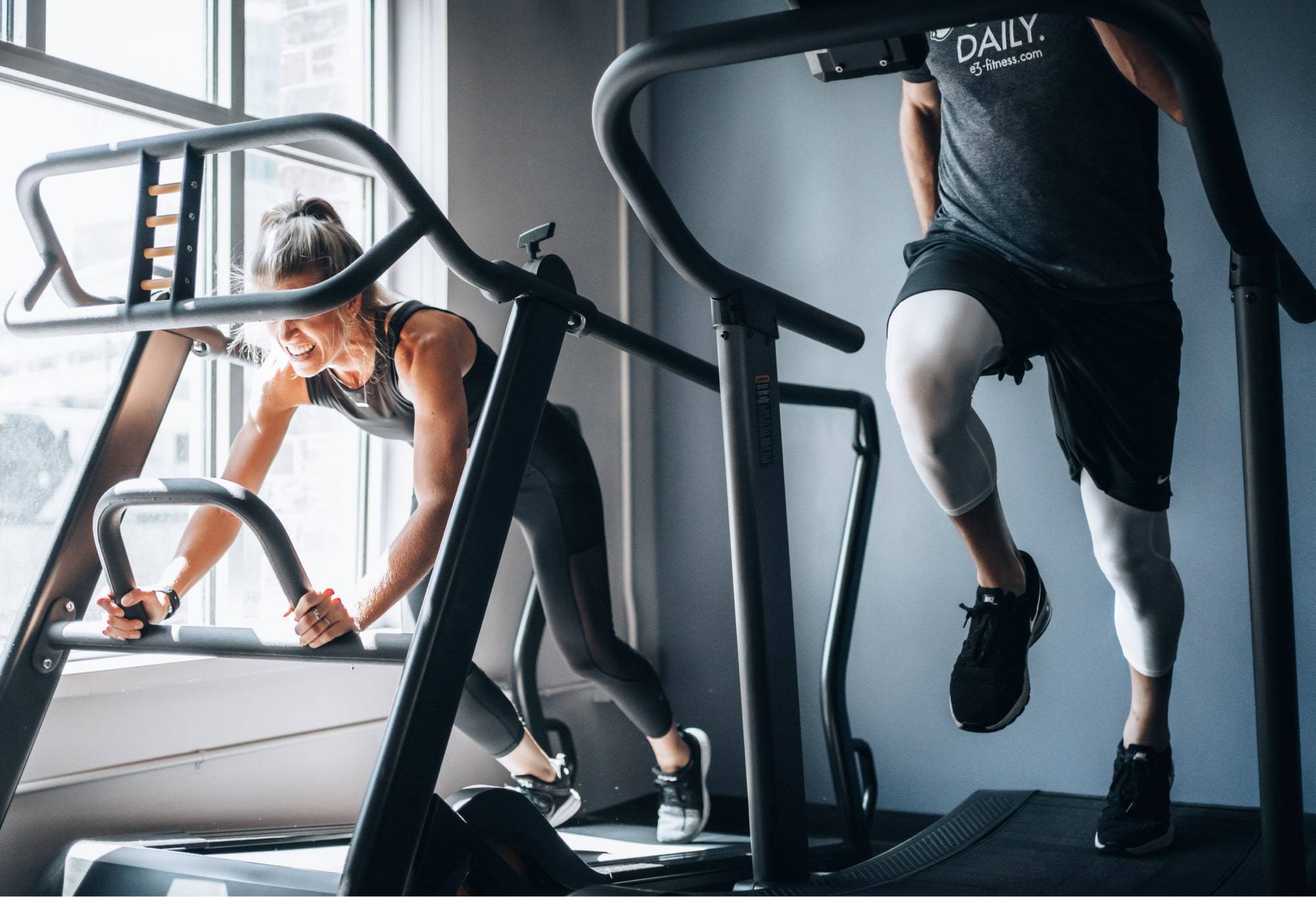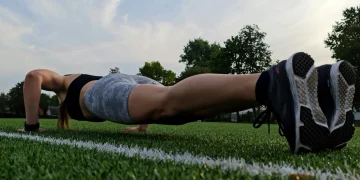What if you plan to run a marathon, but some conditions like bad weather (ice, storm wind, severe frost, a high air temperature), your work schedule, or some other emergency prevent your usual preparation?
In this case, the only solution is to use a treadmill. We have gathered treadmill running tips and examples of workouts for you to prepare with comfort and avoid injuries.
Benefits of a Treadmill Marathon Preparing
- Independence of the weather conditions – you can run regardless of rain or snow
- Ability to control your speed while running and develop your skills
- Easier access to food and drinks as you can put them next to you
- Ability to boost your mood and mental condition
- Improve sleep quality and brain activity
Treadmill Tips
How to run on a treadmill? Follow the right technique. By doing this, you not only increase training effectiveness but also prevent injuries. What are the requirements?
- Look straight ahead. Do not look down as lowering your head puts strain on your neck and upper back. Bending your neck affects your posture and makes it difficult to breathe. Also, if you look at the track, you risk getting dizzy.
- Don’t slouch. This is a common mistake for a lot of people. You should keep your shoulders relaxed by periodically lowering and shaking your hands.
- Keep your back straight. Be sure to keep your body straight: the treadmill will pull your legs back, but you don’t have to lean forward too much. Otherwise, you may feel pain in the neck and back or even lose your balance.
- Breathe through your mouth and nose. Beginner runners on treadmills that only breathe through the nose may not take in enough air for the running load. If you want to fully satisfy the body’s needs, also breathe through the mouth.
- Don’t put your foot too far forward. Pay attention to where your foot goes when it lands. It should be directly under the body and not far from it. Excessive forward movement can lead to the stretching of muscles and tendons. You may have to shorten your stride and increase your pace to learn this technique.
- Land lightly in the middle of the foot. It’s very important to run with light steps, touching the ground with the middle of your foot, not your toe or heel. It will help you to avoid injuries. According to a study, the main difference between the treadmill and real-world running lies precisely with sagittal plane kinematic differences at the footstrike. These differences can lead to trauma in untrained runners if they don’t follow the technique.
- Don’t turn your feet to the side. Your toes should point straight ahead when you run. If this is difficult, reduce your speed and incline, and just run with your feet on an imaginary or outlined line.
- Work with your hands. Keep your hands at an angle of no more than 90 degrees, and actively help yourself by moving them. Remember that the hands should not cross the center of the chest because otherwise, you will artificially limit the amount of air that can get into the lungs. Also, make sure your palms are open and not clenched into fists.
Every part of your body has a role to play. And if one part is in the wrong position or makes the wrong movements, it affects the rest. This is where injury and imbalance come from.
Other treadmill recommendations for marathon training include staying hydrated, using comfortable shoes, and having an effective training plan.
What Should You Know About Marathon Training on a Treadmill?
Before we move to specific workouts for you to add to your plan, we should consider answers to the most popular questions.
Differences Between Treadmill and Real-Time Running
Before you start training, you should know that a treadmill has features that may lead to different consequences. For example, after a couple of months of work, your joints, ligaments, and muscles will experience a real shock when you start your race on a natural road. There is even a risk of injury.
Why does it happen? Running on a treadmill is very different from running on the ground. The track absorbs the impact of the foot during landing, preserving the joints and bones. Road training gradually adapts the legs and prepares the musculoskeletal system for the upcoming marathon, while the treadmill tries to protect your feet and decreases the level of impact loading.
The result for some runners is trauma due to the impact load being higher than they are used to. To prevent it, follow our advice in technique and use the incline of the track to imitate the real road.
How to Do Long Runs on the Treadmill?
Long runs are necessary to increase endurance and effectively prepare the muscles for a marathon. How do you get proper distance training on a treadmill?
Many modern treadmills are inclined adjustable, and some are even designed to simulate going downhill (you should work with an incline to increase the energy cost). It helps you to prepare for almost any track and spend less time and effort adapting to the conditions of a real race.
However, doing a long run on the treadmill has some drawbacks. You will not be able to work on balance and maneuvering to practice cornering because treadmills are simply not designed for training in such realistic conditions.
What About Speed Workouts for Marathon Training?
Treadmill running allows you to be extremely specific about your speed workouts which is a major benefit when training for a marathon. You see all your running data right in front of you and can observe and correct your speed in real time.
Moreover, many treadmills allow you to program specific workouts. All you have to do is run and keep up!
What Can I Do to Make the Training not so Boring?
This is a common question for runners who choose marathon treadmill training. While running on the road, you can observe scenic landscapes, buildings, and people, but you don’t have that on the treadmill.
It’s not a big problem – you can listen to music, audiobooks, or watch your favorite TV show while running. Plus, when you work out on a treadmill, it is easier for you to get food and drinks.
How to Practice My Goal Pace for Marathon Training on a Treadmill?
The closer you get to race day, the more important it is to train at your goal marathon pace. As we have said above, the good thing about running on a treadmill is that you can adjust the speed to achieve your desired workout pace.
Let’s imagine that you plan to run 16 miles using a treadmill.
The workouts can look like this:
- The first variant is to run the entire distance at a calm long-distance pace.
- The second variant is to divide the distance into several blocks focusing on your target marathon pace:
- 5 mi at a calm long-distance pace;
- 2 mi at your marathon goal pace;
- 2 mi at a calm long-distance pace;
- 2 mi at your marathon goal pace;
- 5 miles at a calm long-distance pace.
- The last variant is to structure your workout as a quick finish long run:
- 12 mi at a calm long-distance pace;
- 4 mi at your marathon goal pace.
Indoor Marathon Training: Treadmill Workouts for Your Marathon Training Plan
Interval Workout
You can adapt marathon training to the treadmill. It can look like this:
- Start with 10 min easy warming-up running on a 1-3% incline;
- Add 6×3 minutes at 5k race pace on 3% incline (90-sec walking recovery between reps);
- Finish with 5 minutes of easy running to cool down on a 1-3% incline.
Hilly Workouts for Building Speed and Strengthing Your Legs
Also called pyramid training, this type of workout has a great effect and can be adapted for a treadmill. This variant is good for those who are not good when running fast during interval sessions on a flat track and want to develop their productivity.
- Start with 10 min easy warming-up running at a 1-3% incline;
- Continue with 2 min reps at 5k race effort on 6%, 8%, 10%, 12%, 10%, 8%, and 6% inclines (60 sec of walking recovery at 1% incline between all reps);
- Finish with a 5 min easy run at a 1-3% incline.
Tempo Workouts
Every skilled runner knows that tempo workouts are irreplaceable if you want to develop your lactate threshold and train your body for faster and longer running.
- Start with 5 min easy warming-up running on a 1-3% incline;
- Continue with 15 min at your target marathon pace on a 3% incline;
- Move on with 10 minutes at your half-marathon pace on a 3% incline;
- Then run 5 min at your 10k race pace on a 3% incline;
- Finish with a 5 min easy cool-down run on a 1-3% incline.
Wrap Up
You can prepare for your marathon with treadmill workouts added to your marathon training plan. But you should follow the proper technique; otherwise, you risk getting injured. To prepare well, use our tips for training and try our sample of workouts.






